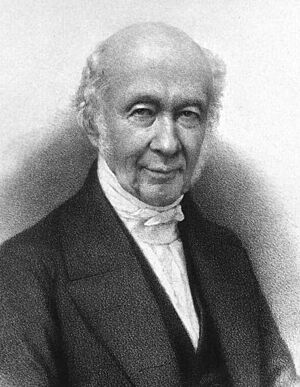Carl Reichenbach facts for kids
Quick facts for kids
Carl Reichenbach
|
|
|---|---|

Carl Ludwig von Reichenbach
|
|
| Born |
Karl Ludwig Freiherr von Reichenbach
February 12, 1788 |
| Died | January 19, 1869 (aged 80) |
| Nationality | German |
| Alma mater | University of Tübingen |
| Occupation | Chemist, geologist, metallurgist, naturalist, industrialist and philosopher |
| Known for | Odic force |
Carl Reichenbach (born February 12, 1788 – died January 19, 1869) was a German scientist. He was a chemist, geologist, metallurgist, and naturalist. He was also an industrialist and a philosopher.
Reichenbach was famous for finding many important chemicals. These chemicals came from tar. Some of his discoveries include paraffin (a waxy substance), pittacal (the first man-made dye), and phenol (used as an antiseptic to kill germs). Later in his life, he studied a new type of energy. He believed this energy came from all living things. He called it the Odic force.
Contents
Life of Carl Reichenbach
Carl Reichenbach went to the University of Tübingen. There, he earned a degree in philosophy. When he was only 16, he dreamed of starting a new German country. He wanted to do this on one of the South Sea Islands. He spent five years working on this big plan.
Later, he became interested in using science for industry. He visited many factories and metalworking places in France and Germany. He then started his own modern metal company. He built forges (places where metal is heated and shaped) in the Black Forest region of Southern Germany.
Carl Reichenbach's Scientific Discoveries
Reichenbach did many original science studies. He wrote the first geological book in Austria. It was called Geologische Mitteilungen aus Mähren (Geological News from Moravia).
He was in charge of large chemical factories. He also ran iron furnaces and machine shops. This gave him great chances to do big experiments. From 1830 to 1834, he studied what happens when you heat organic substances. These included coal and wood tar.
He found many valuable compounds called hydrocarbons. These included creosote, paraffin, and phenol. Phenol and creosote are antiseptics. He also found pittacal and cidreret, which are man-made dyes. Other discoveries were picamar (used in perfume), assamar, and capnomor. Reichenbach called a mix of these oils "eupione." He wrote about how important these substances could be for the economy.
Earth's Magnetism Studies
Reichenbach also built on the ideas of earlier scientists. One was Galileo Galilei. Galileo thought the Earth's center was linked to a universal force in space. Reichenbach believed that Earth's magnetism comes from magnetic iron. He thought this iron could be found in meteorites.
He reasoned that meteorites and planets are alike. He saw that even small meteorites had magnetic poles. Scientists in the 1800s thought this idea was correct.
The Odic Force Research
In 1839, Carl Reichenbach stopped working in industry. He began to study the human nervous system. He looked into conditions like neurasthenia (a type of tiredness), somnambulism (sleepwalking), hysteria, and phobia (strong fears). He heard that the moon might affect these conditions.
He talked to many patients. He ruled out many causes and cures. But he noticed that these problems often affected people who were very sensitive. He called these people "sensitives."
He was inspired by the work of Franz Anton Mesmer. Mesmer believed in a kind of animal magnetism. Reichenbach thought that environmental electromagnetism might affect these conditions. But his studies led him to a new idea. He proposed a new, invisible force. He thought it was like magnetism. He believed it came from most substances. He saw it as a "life principle" that connects all living things. He named this life energy the Odic force.
Works by Carl Reichenbach
- Das Kreosot: ein neuentdeckter Bestandtheil des gemeinen Rauches, des Holzessigs und aller Arten von Theer (about creosote) 1833
- Geologische Mitteilungen aus Mähren (Geological news from Moravia) Vienna, 1834
- Physikalisch-physiologische Untersuchungen über die Dynamide des Magnetismus, der Elektrizität, der Wärme, des Lichtes, der Krystallisation, des Chemismus in ihren Beziehungen zur Lebenskraft (about the forces of magnetism, electricity, heat, light, and chemistry related to life force) Braunschweig, 1850
- Odisch-magnetische Briefe (Letters on Od and Magnetism) Stuttgart 1852, 1856; Ulm 1955
- Der sensitive Mensch und sein Verhalten zum Ode (The sensitive human and his behavior towards Od) Stuttgart and Tübingen 1854-1855
- Köhlerglaube und Afterweisheit: Dem Herrn C. Vogt in Genf zur Antwort (a response to C. Vogt) Vienna, 1855
- Wer ist sensitiv, wer nicht (Who is sensitive, who is not?) Vienna, 1856
- Odische Erwiederungen an die Herren Professoren Fortlage, Schleiden, Fechner und Hofrath Carus (replies about Od to professors) Vienna, 1856
- Die Pflanzenwelt in ihren Beziehungen zur Sensitivität und zum Ode (The plant world and its relation to sensitivity and Od) Vienna, 1858
- Odische Begebenheiten zu Berlin in den Jahren 1861 und 1862 (Odic events in Berlin) Berlin, 1862
- Aphorismen über Sensitivität und Od (Short sayings on Sensitivity and Od) Vienna, 1866
- Die odische Lohe und einige Bewegungserscheinungen als neuentdeckte Formen des odischen Princips in der Natur (about Odic flame and movements as new forms of the Odic principle) Vienna, 1867
Some of his works were translated into English:
- Physico-physiological researches on the dynamics of magnetism, electricity, heat, light, crystallization, and chemism, in their relation to Vital Force New York, 1851
- Somnambulism and cramp New York, 1860
- Letters on Od and Magnetism 1926
See also
 In Spanish: Carl Reichenbach para niños
In Spanish: Carl Reichenbach para niños
- Reichenbach's Otaheiti Society

